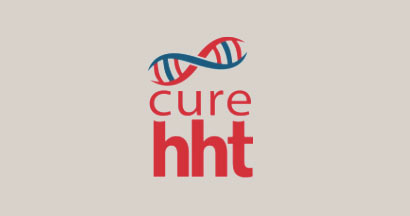A Nosebleed Solution
I can't believe that SOMETHING SO VERY SIMPLE could CHANGE MY LIFE so very much. Cotton balls gave me my life back.
I want to share the following with other HHT patients who are desperately looking, as I was, for a solution for unmanageable nosebleeds. The folks at the University of Utah HHT Center encouraged me to try the technique below when it became clear that laser treatments were no longer helping control my nosebleeds due to the nature and number of telangiectasia in my nose. Over a number of years I have had 14 laser procedures.
Items you will need:
- Cotton Balls
- Band-aids
- Bacitracin ointment
Optional:
- Small scissors
- Blunt ended poker (this is to carefully poke the cotton back if it protrudes from the band-aid, a bobby pin works). Be careful.
Here is what I do:
- I put a small amount of Bacitracin on the fuzzy end of a thumb size piece of cotton that has been folded in half.
- Using my thumb and pointer, I carefully put the cotton into each nostril hole, then try breathing through the nose to see if I used an adequate amount of cotton.
- I then place one side of a lengthwise cut band-aid, (with the gauze side toward the cotton), across the nostril. I carefully pull the nostrils together, (just slightly--don't overdo this part), before placing the sticky part of the band-aid upward on the outside of the nose.
- I use the small blunt ended scissors to clip the length of the band-aid at each nostril crease. Or as I recently found from flying out of town, ( and couldn't take my scissors), you can precut the ends off the band-aids, once you have judged just how long they need to be, to reach the crease of your nostril in order to stick to your skin.
That is all there is to it!!!
Details
I didn't know cotton balls unroll, but they do, so look for that kind. You will need to put in enough cotton to block the air flow and may need to try this several times to find out just how much cotton is right for your nostril size. If you don't have enough the first try, take it out and throw it away, (it's just a piece of cotton). Don't try to put an extra piece on top of the one you have already placed inside the nostril. This will push the first piece too far up, making it difficult to remove. Also, you only need enough cotton to block the air, so don't push it too far up as this may cause a nose bleed. I fold the cotton in half and cover the fuzzy side with the ointment. The ointment helps to prevent infection, keeps the cotton from sticking to the inside, and takes away some of the fuzziness.
Note: Flexible fabric band-aids did not work. I like to hold the gauze side of the band-aid against the nostril opening, and carefully pull the nostrils together as I put the sticky part of the band-aid on. The fabric band-aids have too much give and don't hold the nostril together.
What You Will Notice
- It takes away your ability to breathe through the nostrils (otherwise you are doing it wrong).
- It takes away your ability to smell most things.
- It takes away your ability to taste most things.
- You will begin to feel less fatigued as you're blood count rises.
- I have less junk in my throat and therefore don't need to "snuff and spit" (this always started a nose bleed for me).
- I sneeze less, and my nose doesn't bleed even when I do sneeze.
- Your mouth will be dry. I carry a water bottle with me to sip on. Your tongue will get so dry at night that it will almost feel brittle. Keep a water bottle at your bedside. I woke several times at night, and actually still do. Although I slept restless at first, now I barely awaken for my sip of water and fall right back to sleep. You should get use to this at some point.
- If you do get a nosebleed going down your throat, drink ice water, as much as you can until you notice the bleeding is stopped.
- Most people won't notice your new look, because the band-aid camouflages the cotton. Those that do notice might ask, so explain it to them. Maybe they know someone that could benefit from the same process.
- You will also notice that it just becomes a way of life! Some people wear glasses, some people do the cotton/band-aid thing.
How long will you need to put cotton balls in your nose?
23/7—In other words, take it out only long enough for your three meals a day. No longer than 20 minutes each time, or one hour per day!! I love being able to take it out for meals as I can taste my food, and I don't choke on what I am eating.
This also means the cotton will be changed at least three times per day, which will decrease the risk of infection. I change it again before bedtime and any time that it seems to allow in too much air or becomes moist. Carefully remove the cotton, and at first you may see signs of blood, but JUST KEEP DOING THIS. BE PATIENT AND HAVE A POSITIVE ATTITUDE.
It will not be effective if you don't have the cotton in place 23 hours per day, every day. It works largely because as airflow in and out of the nose decreases, so does the blood volume flowing through blood vessels to the nose. With less blood flowing into the abnormal blood vessels (telangiectases) in the nose, they rarely rupture and bleed.
All I can say is this is really working for me and I can't believe something SO VERY SIMPLE could change my life SO VERY MUCH !!!!
My Thoughts
This is such a miracle in my life at this time. Everyday when I wake up, I can't believe that I have gone another day WITHOUT a nose bleed!! People have NO idea what some HHT people go through. They can't imagine the amount of blood loss and just how badly it pours when it does bleed. We can't cry, laugh, sneeze, lean our head forward, sleep with our head too low, or turned in the wrong direction causing the pressure to shift, when we sleep. All of these cause a nose bleed used to cause a nosebleed, and of course most of the time it bled just for no reason at all. I couldn't even tilt my head forward to kiss my grandkids or tilt it back just a little for a kiss from my husband.
I am in public every single day with my job, and I felt a little self conscious at first. But that literally took just a couple days to get over. Remind yourself that they don't know what you go through, if they did, they would hug you every time they passed by.
I keep a nose bleed journal, and since beginning this method four months ago, I have only had 3 ten-minute nose bleeds and one 1/2 hour bleed. This is great since it prior to this cotton technique I usually had four or five significant bleeds per week. Some of these bleeds were very major, taking one to two hours to stop, and I was chronically anemic! My last blood test numbers were so high from NO BLOOD LOSS that I was able to skip my iron dextran infusion. Yippee!
I have even experienced very hot weather with no nose bleeds and hot weather always caused me problems.
I keep a sandwich bag with cotton balls, Band-Aids, bacitracin ointment, small scissors, small mirror, and a blunt ended poker with me everywhere I go. This is quite a change from what I use to take with me: 3-gal bucket, plastic liners, roll of toilet paper, bowl for ice, cup and straw for ice water, Vaseline and Q-tips.
At first I wanted to go much longer before sharing my good news. I wanted to make sure this wasn't a dream. But I felt like I wasn't being fair to other HHT people that are struggling like I was. I hope you will give this a 100 percent try. I tried it kind of half-heartedly in the past, only using cotton at night or when I didn't have to be in public. But half-heartedly DID NOT WORK. So, put your whole heart into this simple solution. Be patient while you learn the simple process and then do as I do- put in the cotton, cover it with a Band-Aid and go about your day with your head held high.
I hope you find as much success as I have, my prayers are with you!!!!
Please feel free to contact me directly if you have any questions. I would love to walk you through it.
Sandy Seiler
801-699-8806 (mobile)
s.sandy.s@comcast.net



